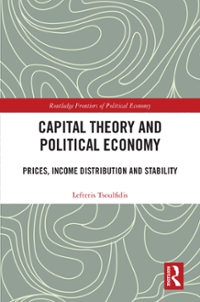Question
he table below shows the amount of savings and borrowing in a market for loans to purchase homes, measured in millions of dollars, at various
he table below shows the amount of savings and borrowing in a market for loans to purchase homes, measured in millions of dollars, at various interest rates. What is the equilibrium interest rate and quantity in the capital financial market? How can you tell? Now, imagine that because of a shift in the perceptions of foreign investors, the supply curve shifts so that there will be $10 million less supplied at every interest rate. Calculate the new equilibrium interest rate and quantity and explain why the direction of the interest rate shift makes intuitive sense.
| Interest rate | Quantity supplied in millions | Quantity demanded in millions |
| 5% | 130 | 170 |
| 6% | 135 | 150 |
| 7% | 140 | 140 |
| 8% | 145 | 135 |
| 9% | 150 | 125 |
| 10% | 155 | 110 |
In capital financial market, savers are represented by supply curve and borrowers are represented by demand curve. The intersection of demand and supply curve determines equilibrium interest rate and quantity at which demand for funds is equal to supply of funds.
In the referred table, equilibrium interest rate is 7% at which quantity of borrowing (Qd) is equal to quantity of lending (Qs),that is, $140million.
With $10 million less supplied at every interest rate, it is found that the equilibrium interest rate is 8% because quantity of borrowing 135 is equal to quantity of lending145-10=135.
Considering the referred table, after reduction of $10 million supply at every interest rate, at 7% interest rate, quantity demanded is $140 million which is not equal to quantity supplied is $140- $10 =$130 million whereas at 8% interest rate, quantity demanded $135 is equal to quantity supplied $145 - $10 =$135 million.
The interest rate has risen from 7% to 8% because after reduction of $10 million supply at every interest rate, there is fewer amount available for supply whereas quantity demanded is same as before.
After reduction of $10 million supply at every interest rate, at 7% interest rate, quantity demanded (Qd) $140 million exceed quantity supplied (Qs) $140 - $10 = $130 million and to meet extra demand in economy, supplier will increase its supply. According to law of supply, supplier will supply more at higher price. Thus, supplier will supply $145 - $10 = $135 million at higher interest rate than 7%, which is 8%.
Therefore, market operates at 8% interest rate which is new equilibrium interest rate and new equilibrium quantity is $135 million in order to meet the extra demand. Hence, the direction of interest rate shifts from 7% to 8% makes intuitive sense.
1. According to the question, paraphrase the answer given. Make corrections if wrong.
Step by Step Solution
There are 3 Steps involved in it
Step: 1

Get Instant Access to Expert-Tailored Solutions
See step-by-step solutions with expert insights and AI powered tools for academic success
Step: 2

Step: 3

Ace Your Homework with AI
Get the answers you need in no time with our AI-driven, step-by-step assistance
Get Started


